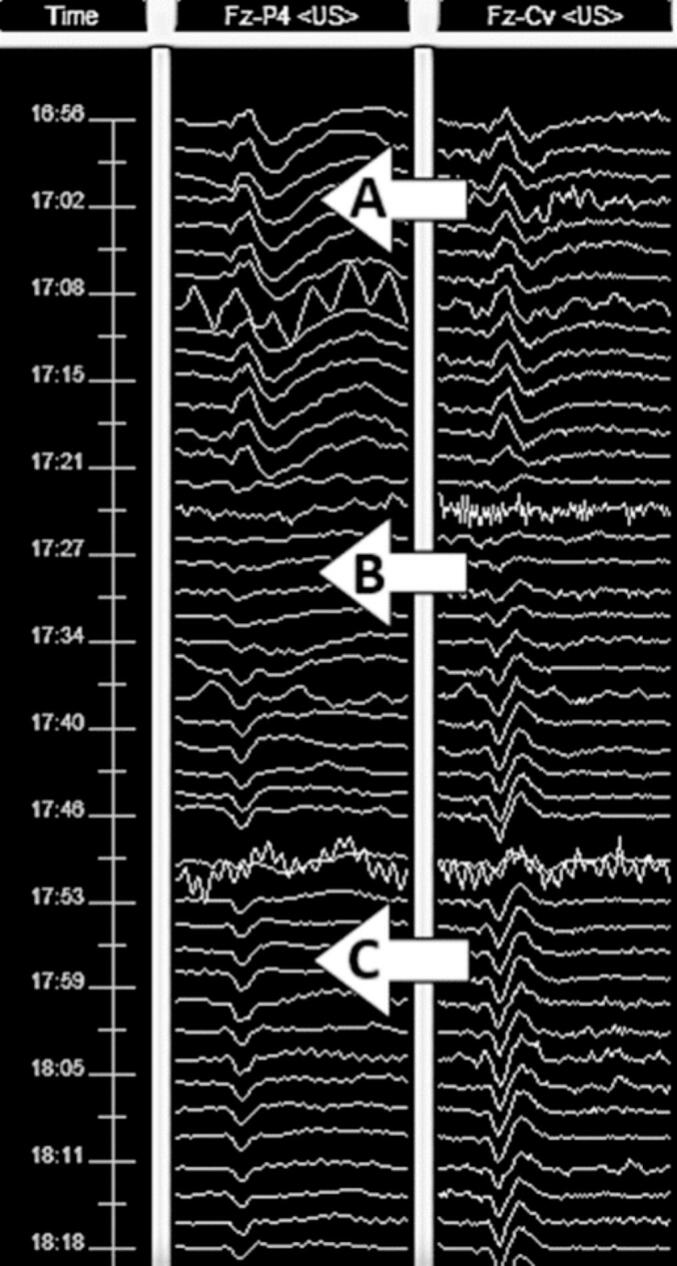术中神经监测作为ICU动脉瘤夹闭术后谵妄的独立预测因子。
Q3 Neuroscience
引用次数: 0
摘要
目的:本研究旨在评估术中显著神经生理监测(IONM)变化作为动脉瘤夹闭患者术后谵妄(POD)的独立预测指标的诊断准确性。方法:回顾性分析2019年至2021年273例开颅动脉瘤夹闭患者的IONM和临床资料。根据视觉资料和临床文献分别评估IONM和POD的显著变化。在ICU使用重症监护谵妄筛查清单(ICDSC)对POD进行多次评估。结果:273例IONM开颅患者中,有83例发生POD(30.4%)。42例患者出现明显的IONM变化,其中19例患者有POD(45.2%)。相比之下,231例患者在手术中没有IONM变化,其中64例(27.7%)患者有POD。多变量分析显示,显著的IONM变化与POD相关,OR: 2.09 (95% CI 1.01-4.43, p值:0.046)。体感诱发电位(SSEP)变化与POD显著相关(p值:0.044)。结论:在接受动脉瘤夹闭开颅手术的患者中,显著的IONM变化与POD风险增加有关。我们的研究结果为未来的研究和分析EEG和SSEP监测提供了强有力的基础,以发现并可能预防POD。本文章由计算机程序翻译,如有差异,请以英文原文为准。


Intraoperative neuromonitoring as an independent predictor for postoperative delirium in ICU following aneurysm clipping
Objectives
This study aims to evaluate the diagnostic accuracy of significant intraoperative neurophysiological monitoring (IONM) changes as an independent predictor of postoperative delirium (POD) in patients undergoing aneurysm clipping.
Methods
IONM and clinical data from 273 patients who underwent craniotomy for aneurysm clipping from 2019 until 2021 were retrospectively reviewed. Significant IONM changes and POD were respectively evaluated based on visual review of data and clinical documentation. POD was assessed multiple times in the ICU using the Intensive Care Delirium Screening Checklist (ICDSC).
Results
Of the 273 patients undergoing craniotomy with IONM, 83 had POD (30.4 %). Significant IONM changes were noted in 42 patients, of which 19 patients had POD (45.2 %). In contrast, 231 patients had no IONM changes during surgery, of which 64 (27.7 %) patients had POD. Multivariable analysis showed that significant IONM changes were associated with POD, OR: 2.09 (95 % CI 1.01–4.43, p-value: 0.046). Additionally, somatosensory evoked potentials (SSEP) changes were significantly associated with POD (p-value: 0.044).
Conclusion
Significant IONM changes are associated with an increased risk of POD in patients undergoing craniotomy for aneurysm clipping. Our findings offer a strong basis for future research and analysis of EEG and SSEP monitoring to detect and possibly prevent POD.
求助全文
通过发布文献求助,成功后即可免费获取论文全文。
去求助
来源期刊

eNeurologicalSci
Neuroscience-Neurology
CiteScore
3.50
自引率
0.00%
发文量
45
审稿时长
62 days
期刊介绍:
eNeurologicalSci provides a medium for the prompt publication of original articles in neurology and neuroscience from around the world. eNS places special emphasis on articles that: 1) provide guidance to clinicians around the world (Best Practices, Global Neurology); 2) report cutting-edge science related to neurology (Basic and Translational Sciences); 3) educate readers about relevant and practical clinical outcomes in neurology (Outcomes Research); and 4) summarize or editorialize the current state of the literature (Reviews, Commentaries, and Editorials). eNS accepts most types of manuscripts for consideration including original research papers, short communications, reviews, book reviews, letters to the Editor, opinions and editorials. Topics considered will be from neurology-related fields that are of interest to practicing physicians around the world. Examples include neuromuscular diseases, demyelination, atrophies, dementia, neoplasms, infections, epilepsies, disturbances of consciousness, stroke and cerebral circulation, growth and development, plasticity and intermediary metabolism. The fields covered may include neuroanatomy, neurochemistry, neuroendocrinology, neuroepidemiology, neurogenetics, neuroimmunology, neuroophthalmology, neuropathology, neuropharmacology, neurophysiology, neuropsychology, neuroradiology, neurosurgery, neurooncology, neurotoxicology, restorative neurology, and tropical neurology.
 求助内容:
求助内容: 应助结果提醒方式:
应助结果提醒方式:


